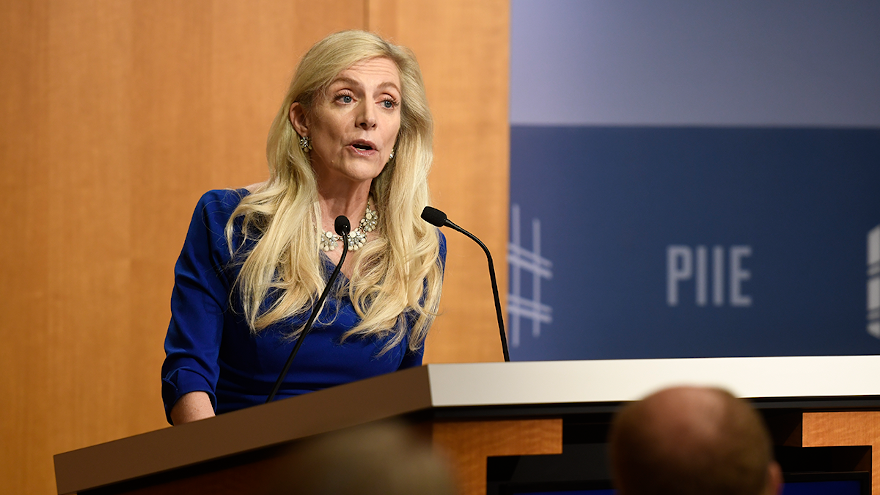Fed upbeat about economy even as consumer confidence wobbles slightly

Federal Reserve governor Lael Brainard, seen here during an event earlier this fall, projected this week that the U.S. economy will continue to grow. Photo courtesy of the Federal Reserve.
By subscribing, you agree to receive communications from Auto Remarketing and our partners in accordance with our Privacy Policy. We may share your information with select partners and sponsors who may contact you about their products and services. You may unsubscribe at any time.
CARY, N.C. –
In separate public appearances this week, two members of the Federal Reserve Board gave similar, upbeat assessments about the economy and the prospects for steady performance next year.
However, one of the prominent measurements of consumer sentiment showed that individuals who might be purchasing vehicles among other spending activities isn’t quite as robust.
First on Monday, Federal Reserve chair Jerome Powell shared his economic assessment during the annual meeting of the Greater Providence Chamber of Commerce in Providence, R.I.
“We have heard two messages loud and clear,” Powell began. “First, as this expansion continues into its 11th year — the longest in U.S. history — economic conditions are generally good. Second, the benefits of the long expansion are only now reaching many communities, and there is plenty of room to build on the impressive gains achieved so far.
“These themes show through in many ways in official statistics,” he continued. “For example, more than a decade of steady advances has pushed the jobless rate near a 50-year low, where it has remained for well over a year. But the wealth of middle-income families — savings, home equity and other assets — has only recently surpassed levels seen before the Great Recession, and the wealth of people with lower incomes, while growing, has yet to fully recover.
“Fortunately, the outlook for further progress is good: Forecasters are generally predicting continued growth, a strong job market and inflation near 2%,” Powell went on to say.
Subscribe to Auto Remarketing to stay informed and stay ahead.
By subscribing, you agree to receive communications from Auto Remarketing and our partners in accordance with our Privacy Policy. We may share your information with select partners and sponsors who may contact you about their products and services. You may unsubscribe at any time.
Then the next day, Fed governor Lael Brainard made a presentation in New York during the 2019 William F. Butler Award ceremonies hosted by the New York Association for Business Economics.
“There are good reasons to expect the economy to grow at a pace modestly above potential over the next year or so, supported by strong consumers and a healthy job market, despite persistent uncertainty about trade conflict and disappointing foreign growth,” Brainard said. “Recent data provide some reassurance that consumer spending continues to expand at a healthy pace despite some slowing in retail sales. Consumer sentiment remains solid, and the employment picture is positive. Housing seems to have turned a corner and is poised for growth following several weak quarters.
“Business investment remains downbeat, restrained by weak growth abroad and trade conflict,” she acknowledged. “But there is little sign so far that the softness in trade, manufacturing, and business investment is affecting consumer spending, and the effect on services has been limited.
“Employment remains strong. The employment-to-population ratio for prime-age adults has moved up to its pre-recession peak, and the three-month moving average of the unemployment rate is near a 50-year low,” Brainard went on to say. “Monthly job gains remain above the pace needed to absorb new entrants into the labor force despite some slowing since last year. And initial claims for unemployment insurance — a useful real-time indicator historically — remain very low despite some modest increases.
With respect specifically to the consumer sentiment that Brainard mentioned, perhaps it’s not quite as healthy as the Fed policymaker noted.
According to a news release on the same day as Brainard’s public appearance, the Conference Board Consumer Confidence Index decreased in November, following a slight decline in October. The index now stands at 125.5, down from 126.1 in October.
Officials noted the Present Situation Index — based on consumers’ assessment of current business and labor market conditions — decreased from 173.5 to 166.9. They added the Expectations Index — based on consumers’ short-term outlook for income, business and labor market conditions – increased from 94.5 in October to 97.9 in November.
“Consumer confidence declined for a fourth consecutive month, driven by a softening in consumers’ assessment of current business and employment conditions,” said Lynn Franco, senior director of economic indicators at the Conference Board. “The decline in the Present Situation Index suggests that economic growth in the final quarter of 2019 will remain weak. However, consumers’ short-term expectations improved modestly, and growth in early 2020 is likely to remain at around 2%.
“Overall, confidence levels are still high and should support solid spending during this holiday season,” Franco added.
The monthly Consumer Confidence Survey, based on a probability-design random sample, is conducted for the Conference Board by Nielsen, a leading global provider of information and analytics around what consumers buy and watch. The cutoff date for the preliminary results was Nov. 15.


